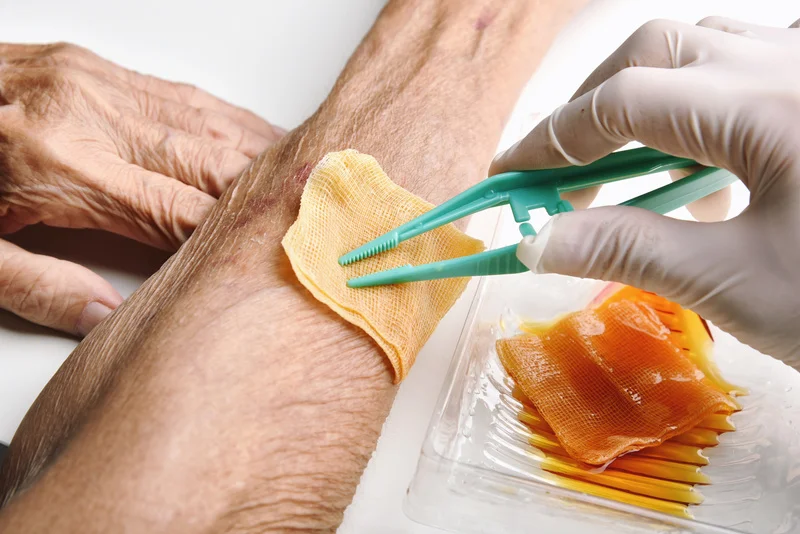Leg ulcers are a common and often painful condition that can significantly impact your quality of life. These open sores or wounds on the legs can take a long time to heal and may recur if the underlying cause is not properly addressed. Understanding the causes of leg ulcers and exploring the available treatment options is crucial for effective management and recovery.

What Are Leg Ulcers?
Leg ulcers are open sores or wounds that develop on the skin of the legs, usually below the knee. They occur when the skin breaks down, exposing the underlying tissues. Leg ulcers can vary in size and depth, and they are often slow to heal. If not properly treated, leg ulcers can lead to serious complications, including infections and chronic pain.
Common Causes of Leg Ulcers
There are several potential causes of leg ulcers, each with its own set of risk factors and associated conditions. Understanding the cause of a leg ulcer is key to determining the most effective treatment. Here are some of the most common causes:
- Chronic Venous Insufficiency (CVI): Chronic venous insufficiency is one of the leading causes of leg ulcers. CVI occurs when the veins in your legs have difficulty returning blood to the heart, causing blood to pool in the lower legs. This increased pressure can damage the skin and lead to the formation of ulcers, often referred to as venous ulcers. These ulcers typically develop around the ankles and are characterized by a shallow, irregular shape with surrounding skin discoloration.
- Peripheral Vascular Disease (PVD): Peripheral Vascular Disease, also known as peripheral artery disease (PAD), is a condition in which the arteries that supply blood to the legs become narrowed or blocked. Reduced blood flow to the legs can result in tissue damage and the development of ulcers, known as arterial ulcers. These ulcers are often found on the feet or toes and may appear as small, round, and deep sores with a pale or necrotic base.
- Diabetes: Diabetes is a major risk factor for leg ulcers, particularly diabetic foot ulcers. High blood sugar levels can damage nerves and blood vessels, leading to poor circulation and reduced sensation in the feet. This can cause minor injuries to go unnoticed, allowing them to develop into ulcers. Diabetic ulcers are often found on the soles of the feet and can be difficult to heal without proper management.
- Pressure Sores: Pressure sores, also known as bedsores or pressure ulcers, occur when prolonged pressure is applied to the skin, particularly over bony areas. This pressure restricts blood flow, leading to tissue breakdown and ulcer formation. Pressure ulcers are common in individuals who are bedridden or have limited mobility and often develop on the heels, ankles, or sides of the feet.
- Infections: Bacterial or fungal infections can also lead to the development of leg ulcers. In some cases, infections can worsen existing ulcers or cause new ones to form, particularly if the immune system is compromised or if there is poor circulation to the area.
- Lymphedema: Lymphedema is a condition in which lymph fluid accumulates in the tissues, causing swelling, particularly in the legs. The swelling can stretch the skin, making it more susceptible to injury and ulceration. Lymphedema-related ulcers are often difficult to treat due to the ongoing swelling and fluid buildup.
- Trauma or Injury: Physical trauma or injury to the legs, such as cuts, scrapes, or burns, can lead to the development of ulcers, especially if the wound does not heal properly. People with underlying vascular conditions or diabetes are particularly at risk for ulcers developing from even minor injuries.

Treatment Options for Leg Ulcers
The treatment of leg ulcers depends on the underlying cause and the severity of the ulcer. Early intervention is crucial for effective healing and to prevent complications. Here are some common treatment options for leg ulcers:
- Treatment of Underlying Conditions: Addressing the root cause of the ulcer is critical for effective treatment. This may involve managing chronic conditions such as diabetes, PVD, or CVI and taking steps to reduce risk factors, such as controlling blood sugar levels, improving circulation, and reducing pressure on the affected areas.
- Wound Care: Proper wound care is essential for healing leg ulcers. This includes cleaning the ulcer regularly, applying appropriate dressings to protect the wound and promote healing, and keeping the area clean and dry. In some cases, specialized dressings that promote moisture balance or contain antimicrobial agents may be used.
- Compression Therapy: For ulcers caused by venous insufficiency, compression therapy is often recommended. Compression stockings or bandages apply pressure to the legs, helping to improve blood flow and reduce swelling. This can aid in healing venous ulcers and prevent them from recurring.
- Medications: Depending on the cause of the ulcer, various medications may be prescribed to manage the condition. For example, antibiotics may be needed to treat infections, while antiplatelet or anticoagulant medications may be used to improve circulation in cases of arterial ulcers. Pain management is also an important aspect of treatment, particularly for severe or chronic ulcers.
- Surgical Interventions: In some cases, surgical procedures may be necessary to treat leg ulcers. This could include procedures to improve blood flow, such as angioplasty or bypass surgery for arterial ulcers, or surgery to remove damaged tissue and promote healing. Skin grafts may also be used to cover large or difficult-to-heal ulcers.
- Lifestyle Modifications: Making lifestyle changes can play a significant role in both treating and preventing leg ulcers. This includes managing underlying conditions like diabetes or high blood pressure, quitting smoking, maintaining a healthy weight, and engaging in regular physical activity to improve circulation.
- Specialized Therapies: For more complex or non-healing ulcers, advanced therapies such as hyperbaric oxygen therapy, which involves breathing pure oxygen in a pressurized chamber, may be used to enhance healing. Other options include negative pressure wound therapy, which uses a vacuum to remove excess fluid and promote tissue regeneration.
To learn more about how these treatments can be tailored to your specific needs, explore our vascular care services that provide comprehensive and personalized treatment options.
Conclusion
Leg ulcers are a serious condition that requires prompt and effective treatment to prevent complications and improve healing outcomes. Understanding the causes of leg ulcers and exploring the available treatment options is essential for managing the condition and preventing recurrence.
If you are experiencing symptoms of leg ulcers, such as open sores, pain, or swelling, it is important to seek medical advice for a proper diagnosis and treatment plan. Early intervention and appropriate care can significantly improve healing and reduce the risk of complications. For more information on managing leg ulcers and maintaining vascular health, visit our comprehensive care page.
Taking proactive steps to treat and prevent leg ulcers can help you maintain a higher quality of life and protect your overall health.

















